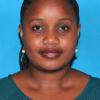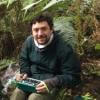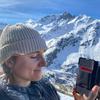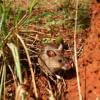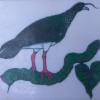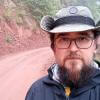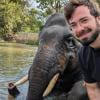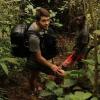Acoustic sensors enable efficient and non-invasive monitoring of a wide range of species, including many that are difficult to monitor in other ways. Although they were initially limited in application scope largely due to cost and hardware constraints, the development of low-cost, open-source models like the Audiomoth in recent years has increased access immensely and opened up new avenues of research. For example, some teams are using them to identify illicit human activities through the detection of associated sounds, like gunshots, vehicles, or chainsaws (e.g. OpenEars).
With this relatively novel dimension of wildlife monitoring rapidly advancing in both marine and terrestrial systems, it is crucial that we identify and share information about the utility and constraints of these sensors to inform efforts. A recent study identified advancements in hardware and machine learning applications, as well as early development of acoustic biodiversity indicators, as factors facilitating progress in the field. In terms of limitations, the authors highlight insufficient reference sound libraries, a lack of open-source audio processing tools, and a need for standardization of survey and analysis protocols. They also stress the importance of collaboration in moving forward, which is precisely what this group will aim to facilitate.
If you're new to acoustic monitoring and want to get up to speed on the basics, check out these beginner's resources and conversations from across the WILDLABS platform:
Three Resources for Beginners:
- Listening to Nature: The Emerging Field of Bioacoustics, Adam Welz
- Ecoacoustics and Biodiversity Monitoring, RSEC Journal
- Monitoring Ecosystems through Sound: The Present and Future of Passive Acoustics, Ella Browning and Rory Gibb
Three Forum Threads for Beginners:
- AudioMoth user guide | Tessa Rhinehart
- Audiomoth and Natterjack Monitoring (UK) | Stuart Newson
- Help with analysing bat recordings from Audiomoth | Carlos Abrahams
Three Tutorials for Beginners:
- "How do I perform automated recordings of bird assemblages?" | Carlos Abrahams, Tech Tutors
- "How do I scale up acoustic surveys with Audiomoths and automated processing?" | Tessa Rhinehart, Tech Tutors
- Acoustic Monitoring | David Watson, Ruby Lee, Andy Hill, and Dimitri Ponirakis, Virtual Meetups
Want to know more about acoustic monitoring and learn from experts in the WILDLABS community? Jump into the discussion in our Acoustic Monitoring group!
Header image: Carly Batist
No showcases have been added to this group yet.
I am a herpetologist interested in bioacoustics, evolution and conservation biology. Currently, I am a postdoc fellow at Universidade Federal de Santa Maria (UFSM), Brazil.
- 0 Resources
- 0 Discussions
- 5 Groups
- @Harsha
- | He/Him
I am a marine biologist / acoustic ecologist from Australia. Fascinated by bioacoustics, I always look forward to learning from people in conservation!
- 0 Resources
- 0 Discussions
- 11 Groups
Alberta Biodiversity Monitoring Institute (ABMI) & SENSR
We track changes in wildlife and their habitats in Alberta, working collaboratively to provide ongoing, relevant, scientifically credible information.


- 2 Resources
- 0 Discussions
- 4 Groups
Holder of BSc in Applied Zoology. Assistant Ecologist at Ruaha National park.


- 0 Resources
- 7 Discussions
- 12 Groups
- @Martincho
- | tincho
Instituto de Ecorregiones Andinas (INECOA)
Postdoc at Instituto de Ecorregiones Andinas (INECOA - Jujuy National University - CONICET).
- 0 Resources
- 1 Discussions
- 2 Groups
University of Zurich
PhD student at the University of Zürich (CH) in PopEcol group, working with camera traps and mammals
- 0 Resources
- 0 Discussions
- 8 Groups
- @fsattar
- | Farook
Farook Sattar received his Technical Licentiate and PhD degrees from Lund University, Sweden. He obtained his B.Eng and M.Eng degrees from Bangladesh University of Engineering & Technology (BUET), Dhaka in Electrical and Electronics Engineering.
- 0 Resources
- 0 Discussions
- 2 Groups
University of Antwerp

- 0 Resources
- 12 Discussions
- 7 Groups
- @sarah_dalrymple
- | she/her
Royal Society for the Protection of Birds (RSPB)

- 0 Resources
- 9 Discussions
- 3 Groups
- 0 Resources
- 2 Discussions
- 3 Groups
British Trust for Ornithology (BTO)
- 0 Resources
- 11 Discussions
- 1 Groups
- 0 Resources
- 0 Discussions
- 4 Groups
Authors developed system to acoustically identify individual animals (under varying conditions) using combo of multi-scale information integration, multi-channel audio & multi-task learning. Tested on captive group...
3 October 2022
'The low-power camera uses power from harvested acoustic energy and communicates colour images wirelessly via acoustic backscatter.' - https://twitter.com/NaturePortfolio/status/1574863768714100738?s=20&t=...
29 September 2022
Authors 'examined effectiveness of acoustic monitoring compared to capture-based & video monitoring of seasonal swarming behavior among Myotis bats in UK. The 3 approaches have advantages & disadvantages for...
27 September 2022
Link
Authors demonstrated "a low cost, simple method to support acoustic tag surveys by identifying tags both from direct acoustic recordings & by reconstructing code packets from processed C-POD data. Method was applied...
26 September 2022
Careers
The Senior Conservation Technology Specialist will be responsible for providing technical advice and capacity development to GWP project teams on conservation technology, distilling challenges and lessons from project...
22 September 2022
Authors developed reproducible passive acoustic monitoring pipeline to rapidly provide baseline information on invasive alien species (IAS); found that IAS occurrence related to high levels of human disturbance.
21 September 2022
Authors "developed a three-hydrophone passive acoustic monitoring system that provides bearing information along with marine mammal detections to allow for informed management decisions in real-time."
20 September 2022
Link
Authors founds dawn & dusk choruses were lost/supressed in plantations, acoustic activity at dawn/dusk reduced in disturbed ecosystems compared to healthy forests.
20 September 2022
The European Biodiversity Partnership Biodiversa+, co-funded by the European Union, has launched a call for research proposals on “Improved transnational monitoring of biodiversity and ecosystem change for science and...
14 September 2022
Careers
The BirdNet team are seeking to fill three roles, including an Ecologist, Data scientist and an Embedded Systems Engineer based in Germany.
9 September 2022
The Purdue University Center for Global Soundscapes is seeking a new postdoctoral fellow to work on a project at the intersection of soundscape monitoring and remote sensing / geospatial data
8 September 2022
August 2025
event
September 2025
event
October 2025
November 2025
event
November 2023
event
event
64 Products
Recently updated products
| Description | Activity | Replies | Groups | Updated |
|---|---|---|---|---|
| Hi Sol,If the maximum depth is 30m, it would be worth experimenting with HydroMoth in this application especially if the deployment time is short. As Matt says, the air-filed case... |
|
Acoustics, AI for Conservation, Data management and processing tools, Emerging Tech, Sustainable Fishing Challenges | 1 year 3 months ago | |
| Oh wow, thank you so much!!!I will keep that four advices in mind! |
|
Acoustics | 1 year 3 months ago | |
| You won't get any audio if you don't allow enough time for the hydromoth/audiomoth to write. So when you do a continuous recording you need to experiment a little. I'm sure there... |
+3
|
Acoustics | 1 year 3 months ago | |
| Congratulations! My first hydromoth was just arrived yesterday and so excited! Looking forward for the update from your project!!! |
|
Acoustics, Animal Movement, Climate Change, Conservation Tech Training and Education, Data management and processing tools, Emerging Tech, Open Source Solutions, Protected Area Management Tools, Sensors, Software Development, Latin America Community | 1 year 3 months ago | |
| If you have the resources, I would suggest testing the sensitivity and directionality of the system at relevant frequencies both with and without an external mic, and let the... |
|
Acoustics | 1 year 3 months ago | |
| Totally agree.Inititally sceptical until I saw Helena and Graeme were involved.MJ |
|
Acoustics, Citizen Science, Community Base, Human-Wildlife Coexistence | 1 year 3 months ago | |
| 'Most importantly, we have to make it play a MIDI version of the DoctorWho theme song when you arm the device. That has to be the #1 feature if you ask me!' Seconded! |
+9
|
Acoustics, Animal Movement, Emerging Tech, Open Source Solutions, Sensors | 1 year 4 months ago | |
| We've deployed passive acoustic monitors in various urban environments without any issues of theft, even in locations where camera traps and other technology has been historically... |
+5
|
Acoustics | 1 year 4 months ago | |
| We could always use more contributors in open source projects. In most open source companies Red Hat, Anaconda, Red Hat and Mozilla, people often ended up getting hired largely... |
|
Acoustics, AI for Conservation, Conservation Tech Training and Education, Early Career, Marine Conservation | 1 year 4 months ago | |
| Hello everyone, I'm interested in gathering insights on how the behavior of different species impacts the development and efficacy of... |
|
Animal Movement, Acoustics, Camera Traps, eDNA & Genomics, Emerging Tech, Marine Conservation | 1 year 4 months ago | |
| Thank you Carly, I will definitely take a look. |
|
Acoustics, Animal Movement, Climate Change, Conservation Tech Training and Education, Data management and processing tools, Geospatial, Software Development | 1 year 4 months ago | |
| Hi @timbirdweather I've now got them up and running and winding how I can provide feedback on species ID to improve the accuracy over time. It would be really powerful to have a... |
|
Acoustics, AI for Conservation, Citizen Science, Emerging Tech | 1 year 5 months ago |



